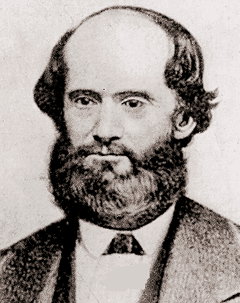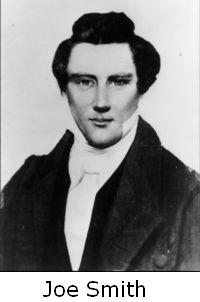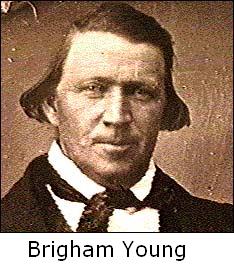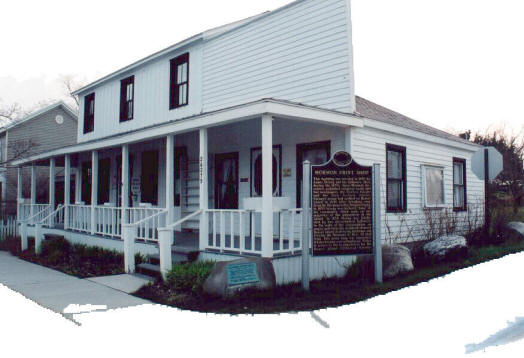James Jesse Strang

Born Jesse James Strang on March 21, 1813 in New York. Joined the baptist church at age of twelve, and studied law at the age of 21. He married a woman named Mary, had three kids, and lived in Chautauqua County, New York, where he worked as a lawyer, minister, a teacher, and postmaster.
When he lost his postmaster position in 1843, he and his family moved to Wisconsin, and then to Nauvoo, Illinois. It was here that he met Joseph Smith Jr., founder of the Mormom religion that was just taking off. Strang converted to the Mormon Church (not mormonism, which is diffrent), was baptised within three months, and became an elder of the church.
Strang was so protective of his new church that he destroyed the office of a newspaper that spoke ill of Mormons
 and the Mormon Church. For this crime, he was sent to jail. While in jail, Smith was assassinated in Carthage, Illinois on June 24, 1844, succumbing to the same fate as most modern men-of-God.
and the Mormon Church. For this crime, he was sent to jail. While in jail, Smith was assassinated in Carthage, Illinois on June 24, 1844, succumbing to the same fate as most modern men-of-God. After Smith's death, Strang and Brigham Young, both elders of the church, said that Smith chose them to lead the Mormons. Strang even brought forward a document, signed by Smith, stating that Strang was to lead. There was always the possibility of them both being right, leading to a system of checks and balances, much like that of Ancient Rome - the world's major power at the time of Jesus Christ. In spite of this possiblity and theory , the Mormons split into two branchs - Brighamites and Strangites.
 Young took his followers to Utah, and founded Salt Lake City. Strang, however, took his followers north, to Wisconsin. Strang's hold on his followers was that of and iron fist. He frowned upon material possessions, was strict against polygamy, stated that women must wear bloomers, and forbade eating meat.
Young took his followers to Utah, and founded Salt Lake City. Strang, however, took his followers north, to Wisconsin. Strang's hold on his followers was that of and iron fist. He frowned upon material possessions, was strict against polygamy, stated that women must wear bloomers, and forbade eating meat. In order to convince his followers of his divinity, Strang announced to his
 people that he had been visited by an angel, and had been given a vision of an ancient people. He and four of his elders went to an oak tree beneath the White River Bridge on September 13, 1845. Beneath the tree, they found a clay case with six brass plates. Upon examintaion, the deep rooted grass appeared to have not been disturbed before they started digging. To his followers, this was proof that they were right about Strang being a prophet, this was further "proven" with the fact that only Strang could "decypher" the plates.
people that he had been visited by an angel, and had been given a vision of an ancient people. He and four of his elders went to an oak tree beneath the White River Bridge on September 13, 1845. Beneath the tree, they found a clay case with six brass plates. Upon examintaion, the deep rooted grass appeared to have not been disturbed before they started digging. To his followers, this was proof that they were right about Strang being a prophet, this was further "proven" with the fact that only Strang could "decypher" the plates. Strang begane looking to a place for him and his peaple to live in peace, finding Beaver Island in northern Lake Michigan. With it's harbor, forests, and fishing, Strang desided that it was here that he would build his kingdom. In June 1848, at least 100 of Strangs followers went over on a steamer to this new promise land. One of these followers was Elvira Field, disguised as Charles Douglas, whom Strang had taken as a second wife in secret, in spite of his views on polygamy.
On July 8, 1850, he proclaimed himself king of the Kingdom of God on Earth (their name for Beaver Island and nearby areas), following the instructions of
 the tables. Claiming to be king of only the Mormons of Beaver Island, he, infact, became a tyrant of the rest of the area. He ordered the non-Mormons pay the Mormon taxes, and punished those who refused. He also demanded to the county treasurer an additional 10% of the taxes collected from the island. Strang's kingdom had a large log temple, a saw mill, a schooner, and a newspaper - the Northern Islander, which Strang was the editor in cheif, furthering his grip on the community. To further tighten the rope, most of the political offices in the area where held by some of Strang's followers by 1851.
the tables. Claiming to be king of only the Mormons of Beaver Island, he, infact, became a tyrant of the rest of the area. He ordered the non-Mormons pay the Mormon taxes, and punished those who refused. He also demanded to the county treasurer an additional 10% of the taxes collected from the island. Strang's kingdom had a large log temple, a saw mill, a schooner, and a newspaper - the Northern Islander, which Strang was the editor in cheif, furthering his grip on the community. To further tighten the rope, most of the political offices in the area where held by some of Strang's followers by 1851. Eventually, the friction became so great between Strang's followers and the other peaple of the island, including Mormons, that a war broke out. The War of Whiskey Point was short lived, however. It was won by Strang and his followers when he shot a canon into a large crowd that had gathered by the general store on Independance Day, 1850. With their tails between their legs, most non-Strangites abandonned their old homes for a new life on the mainland. However, the peaple of Mackinac (Maak-in-aw) Island, felt his grip from even across the Straits of Mackinac, continued the work of non-Mormons.
When people thaught that Strang was strange enough, he became even stranger in 1852 when he went against his polygamy views again, and stated that each of the elders of the church should take a second wife. Strang himself took no less than five wives by 1855. With these five wives, Strang fathered twelve children.
Mackinac Island's economy suffered from the favoritism of Beaver Island over Mackinac Island that the passing ships felt. This favoritism was caused by Strang's improvements of Beaver Island during his rule, and so Strang was to blame. They, along with a defected Strangite named George Adams, they claimed that Strang had threatened Mrs. Adams and punished women caught without the proper Strangite undergarment: bloomers. This got Strang arrested, but not for very long. In 1851, a Strangite caught some of the Catholic Irishmen from Mackinac brewing a whiskey to sell to the local Native Americans. As selling whiskey to the Natives was illegal at the time, the Mormon confronted them. The details of the confrontation is currently unknown, though the Mormon did not report the Irishmen, possibly out of mercy. The Irishmen went to the authorities and charged the Mormans with theft. However, this time Strang wasn't bothered a bit. It wasn't untill a month later, when two non-Morman Beaver Islanders attacked a Mormon, that things became serious. The sheriff tried to arrest the men, four other men got involved, and there was a shootout. One man got killed, one was injured, the sheriff was injured, one was captured, and one got away. Now that there was bloodshed, Michigan's "Mormon trouble" was in full throttle.
Each side acussed the other of starting the shootout. The major cities like Chicago, Buffalo, and Detroit of the area where printing out outrageous stories in their newspapers. President Millard Fillmore himself read one of these stories when he happened to be visiting Michigan. He ordered the USS MICHIGAN on the scene immediately. The "Mormon trouble" was now a national concern. The MICHIGAN and its commanding officer, George Bates, had orders to bring Strang and the Strangites to Detroit for trial. They happened upon J.M. Greig, a Strangite judge, in Mackinac County. They took him prisoner, and at 2:00 a.m. on May 24, they rowed up to Beaver Island, forced Greig to point out Strang's house, and surrounded it. The MICHIGAN took Strang and 100 other Strangites to court, where they were charged with mail robbery, tax evasion, smuggling timber, counterfeiting, and treason. Strang and the other 100 Mormons walked out scott free.
Things really got off when Strang worked his way into the Michigan State Legislature. As a state politicion, he banished all Mackinac Islanders from Emmett County, where Beaver Island was. The Mackinac Islanders then charged Strang and his Mormons with robbery, destruction of private property, false ownership, and piracy. They then declared war on the Mormons, without informing them. On July 12, a Mormon sheriff and 13 other Mormons went to the Emmett County mainland to look for jurors, but Pine River they were ambushed by many armed men. The Mormons and the sheriff piled into their boat, but the pursuers were in hot pursuit. However, the passing ship, the MORGAN, intervened and saved the lives of the 13 Mormons.
In Chicago, Captain Bigelow of the MICHIGAN receaved a message from a Mr. Smith, pleading for assistance, stating that he, his family, and others on Beaver Island were being terrorized by Strang. Upon his aproach, Bigelow learned that Smith was a Mormon, and desided not to interfere with inner-church problems. However, he should have gone anyway, as there wasn't a decrease in complaints of Strang. He was even accused of adding residences to the census reports, to further increase his cut of the county taxes. They were also accused of pirating up and down Michigan's and Wisconsin's shores. Captain Charles McBlaire, the new captain of the MICHIGAN, took action, but was told by Strang that they were all false. Strang was a legislature, what could McBlaire do? Nothing, he could do absolutely nothing. the people themselves could do little more than drop out of the church.
One day in 1856, David Brown came home to find his wife with Thomas Bedford. Strang ordered nearly 80 lashes to be delt to Bedford. After that, Bedford practiced with his pistol. McBlaire, acting on more complaints, went to
It is unknown whether McBlaire had anything to do with the attack, but it is known that he made a stop in Milwaukee on his way, where he let off the two Mormons that delivered the complaint, so that they could inform Strang of his upcoming visit ahead of time. Those same Mormons could have also informed Bedford and Wentworth. Whether he did or not, he was still considered an accomplice, in a way. After the shootout, the assassins took refuge in the MICHIGAN. McBlaire refused to turn them over to the Beaver Island sheriff, so he turned them over to the Mackinac Island sheriff, where they were treated as heroes. After Strang died, the Mormons were kicked out, and the MICHIGAN only intervened to stop the non-Mormons of Beaver Island from killing themselves over the spoils of their long-awaited victory.
Today, the Old Mormon Print Shop still stands, and is the only building
 remaining from the era. Even the log temple is no more. Today, the print shop is the Beaver Island Historical Society Museam, and overlooks the sign that marks the spot where Strang was ambushed. The spirit of Strang is said to haunt the Museam. Late night strollers can see his ghost sitting in one of the rocking chairs on the front porch. One can especially feel a sensation of being watched on the second floor.
remaining from the era. Even the log temple is no more. Today, the print shop is the Beaver Island Historical Society Museam, and overlooks the sign that marks the spot where Strang was ambushed. The spirit of Strang is said to haunt the Museam. Late night strollers can see his ghost sitting in one of the rocking chairs on the front porch. One can especially feel a sensation of being watched on the second floor. This site created by Jon Lamphere, on February 6, 2007
Sources
Back